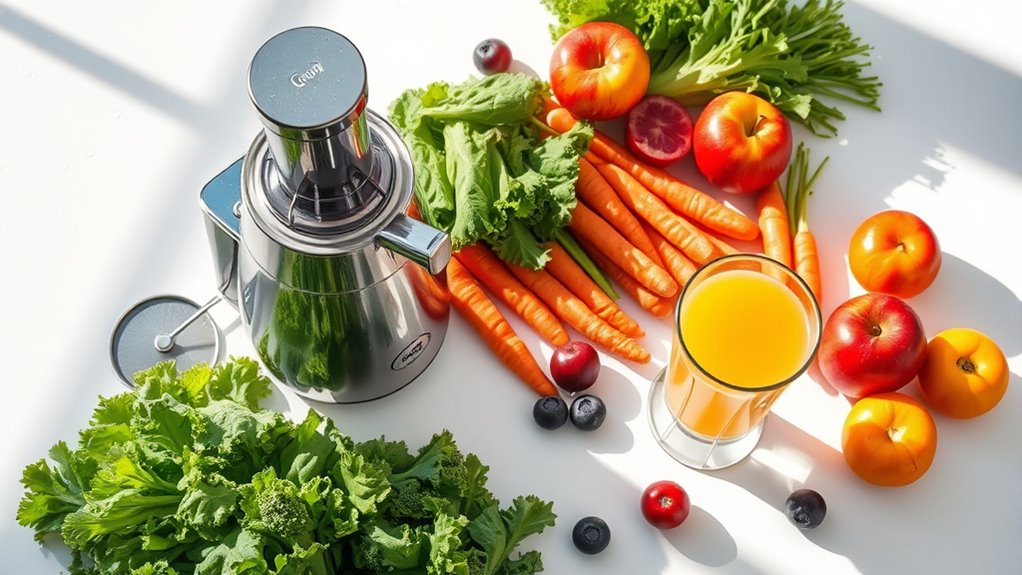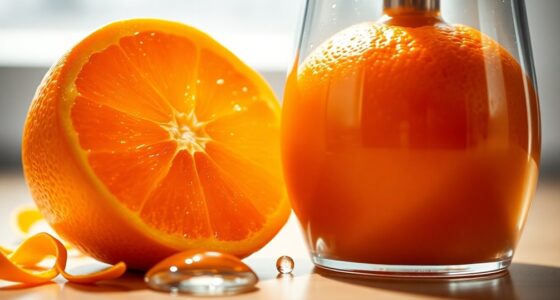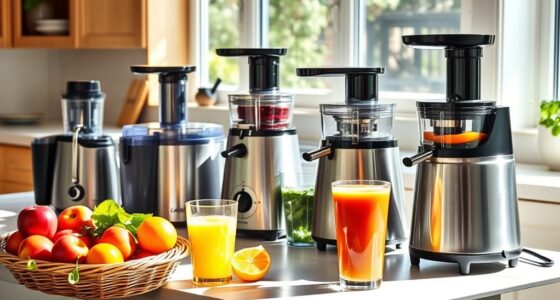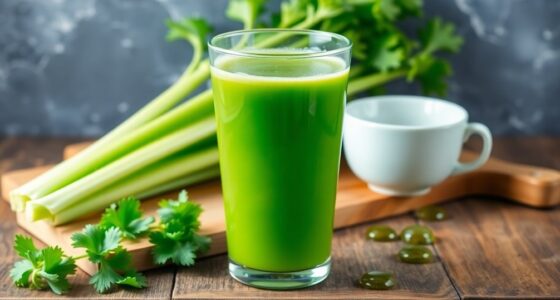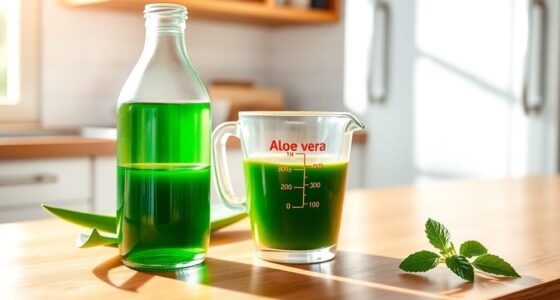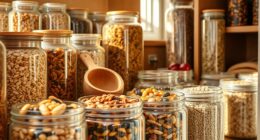Juicing is a fantastic way to boost your health by extracting the natural liquids from fresh fruits and vegetables. It packs a concentrated punch of vitamins, minerals, and antioxidants that can energize you and improve digestion. Choosing the right juicer is key—think about types like centrifugal or masticating. With the right tips for juicing and storage, you’ll maximize freshness and flavor. Keep going to discover more about easy juice recipes and tips to enhance your juicing journey!
Key Takeaways
- Juicing extracts nutrients from fruits and vegetables, offering concentrated vitamins, minerals, and antioxidants in every glass.
- Choose the right juicer type—centrifugal for speed, masticating for nutrition, or twin gear for leafy greens.
- Store juice in airtight glass jars, filling them to the top to reduce oxidation and maintain freshness.
- Incorporate high-water content fruits and leafy greens for hydration and added nutrients in your juice recipes.
- Always balance juice intake with water consumption to ensure optimal hydration during your juicing journey.
What Is Juicing?
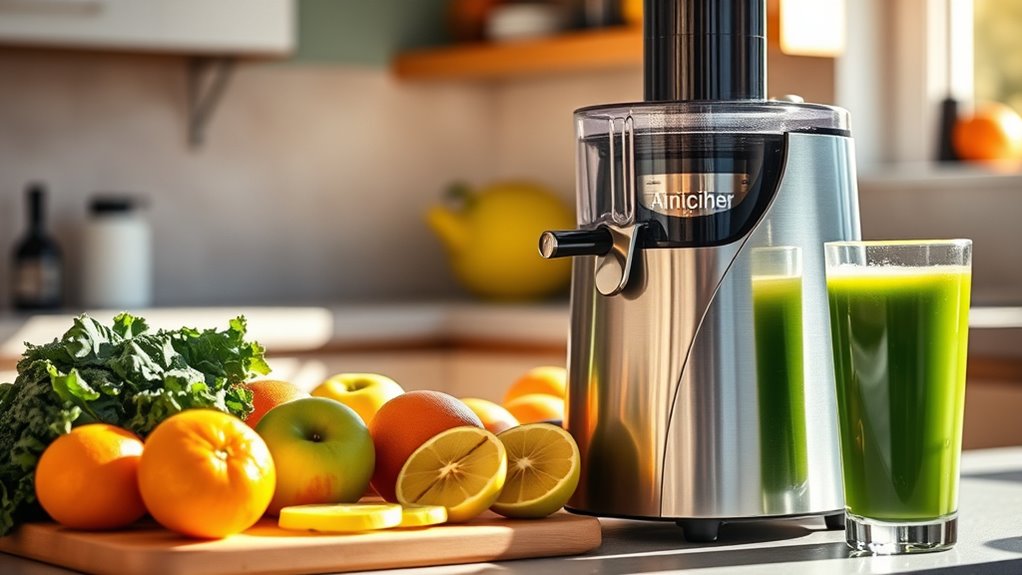
Juicing is a popular method for extracting the natural liquids from fresh fruits and vegetables, making it easier for you to boost your nutrient intake.
The juicing process involves separating juice from pulp and fiber, enhancing your absorption of vitamins, minerals, and antioxidants. By using raw fruits and vegetables, you can create fresh juice that’s free from added sugars and artificial flavors commonly found in store-bought options.
This homemade approach retains all the natural health benefits, allowing you to enjoy a concentrated source of nutrition. Plus, juicing makes it simple to incorporate a wider variety of produce into your diet.
Just one glass can deliver more nutrients than you might consume in an entire day from solid foods, promoting your overall health.
Benefits of Juicing
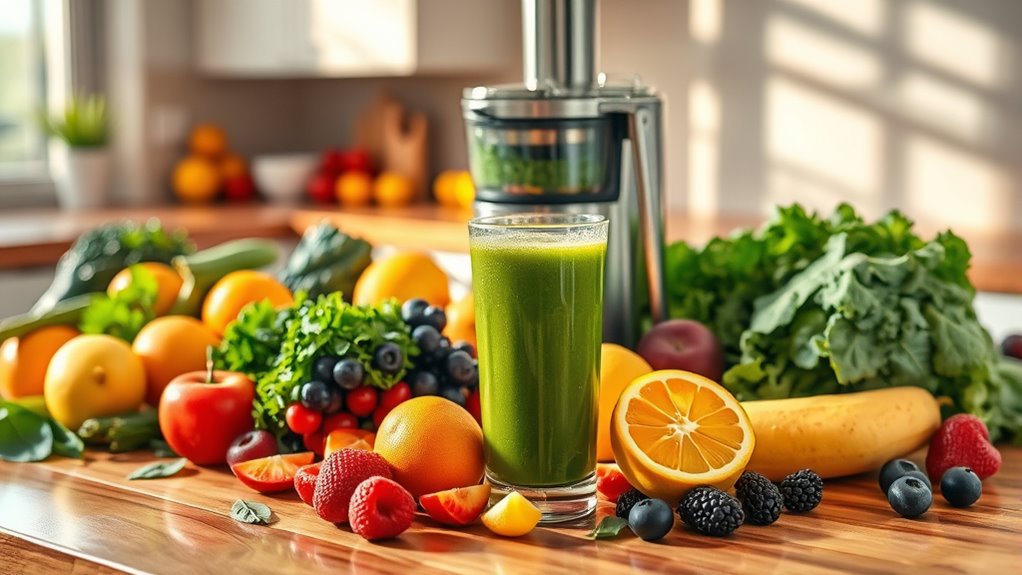
If you’re looking to enhance your health, incorporating fresh juice into your routine can be a game changer.
Juicing provides a concentrated source of vitamins, minerals, and antioxidants, allowing your body to absorb nutrients more efficiently. Regular juicing can boost your energy levels, improve digestion, and promote clearer skin, all thanks to the high intake of fresh produce.
Juicing offers a powerful boost of nutrients, enhancing energy, digestion, and skin clarity through fresh produce.
It’s also a fantastic aid for weight loss, offering low-calorie, nutrient-dense options that help release stored fat. Plus, the soluble fiber in juice can help moderate blood glucose levels and lower LDL cholesterol, making it beneficial for those with diabetes or heart issues. Additionally, juices rich in vitamins A, C, and E can further enhance skin health and combat aging.
Explore various juice recipes to enjoy these incredible benefits and support your overall health!
Choosing the Right Juicer
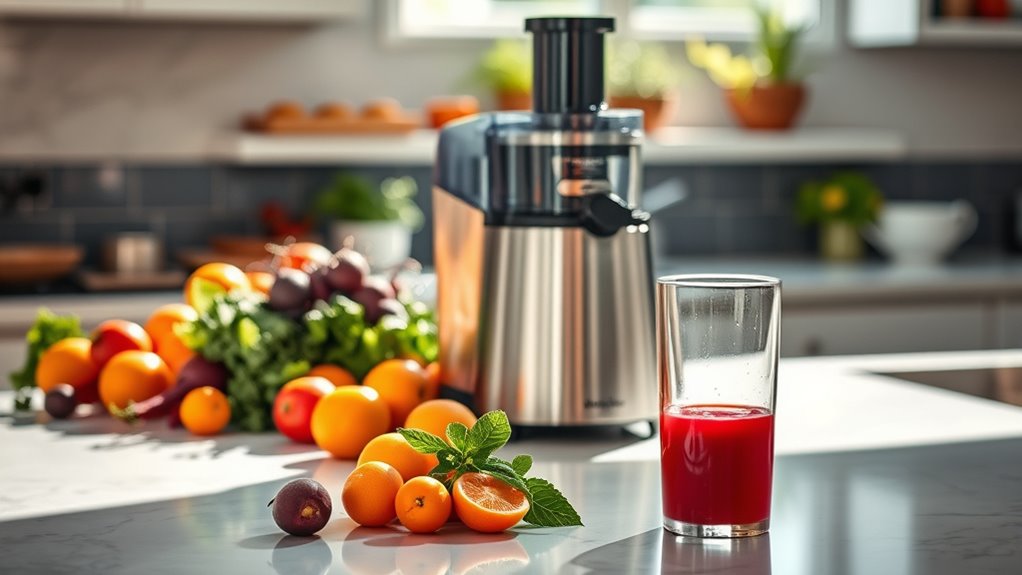
When it comes to choosing the right juicer, you’ll want to understand the different types available, like centrifugal and masticating juicers.
Consider key features that matter to you, such as ease of cleaning and warranty options, along with your budget.
Juicer Types Explained
Choosing the right juicer can feel overwhelming, especially with the variety of options available to suit different needs and preferences.
Here are three popular juicer types to take into account:
- Centrifugal Juicer: Known for speed and affordability, this juicer spins quickly but may produce juice with a shorter shelf life due to oxidation.
- Masticating Juicer: Also called cold-press juicers, they extract juice slowly, offering higher nutritional value and longer-lasting juice, ideal for storing up to 72 hours.
- Twin Gear Juicer: Great for leafy greens, this type yields high juice amounts but can be larger and tougher to clean.
Choosing the right juicer type guarantees you juice right for your lifestyle and preferences! Additionally, consider the shelf life of freshly squeezed juices when planning your juicing routine to maximize freshness and flavor.
Key Features to Consider
After narrowing down the type of juicer that fits your needs, it’s time to focus on the key features that can enhance your juicing experience. Consider the following table to help you choose wisely:
| Feature | Centrifugal Juicers | Masticating Juicers |
|---|---|---|
| Speed | Fast | Slower |
| Ease of Cleaning | Cumbersome | Easier |
| Juice Quality | Lower | Higher |
| Warranty Options | 1-3 years | 5-15 years |
Evaluate the ease of cleaning, as masticating juicers typically have fewer parts. Also, look for a wide feed chute to save prep time. Finally, check the warranty options, which reflect durability and manufacturer confidence in their juicers.
Budget-Friendly Options Available
Finding a budget-friendly juicer doesn’t have to be an intimidating task. With a little research, you can find the perfect one for your needs. Here are three options to evaluate:
- Centrifugal juicers: These are often more affordable and great for quick juice prep, making them ideal for beginners.
- Breville entry-level models: They balance cost and quality, ensuring you get a good juicer without overspending.
- Consumer reviews: Always check ratings to find models that provide the best value for your money.
If you plan to juice leafy greens, think about investing in a masticating juicer for better results.
With these tips, you’ll be well on your way to juicing success without breaking the bank!
Types of Juicers
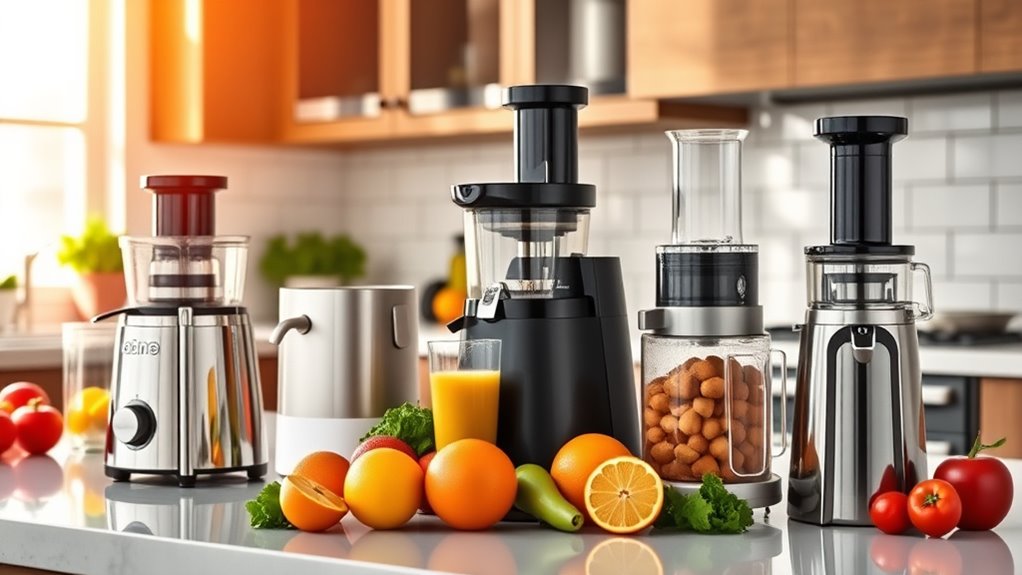
When it comes to juicers, understanding the different types can make all the difference in your juicing experience.
Centrifugal juicers are user-friendly and affordable, perfect for quick juice recipes, but they may struggle with leafy greens and produce juice that oxidizes faster.
On the other hand, masticating juicers, or cold-press juicers, extract juice slowly, preserving nutrients and offering long-term health benefits, with juice that lasts up to 72 hours in your fridge.
Masticating juicers extract juice slowly, preserving nutrients for lasting health benefits and freshness for up to 72 hours.
If you’re juicing a lot of leafy greens, consider twin gear juicers for their nutrient preservation, though cleaning can be tricky.
Finally, citrus juicers are great for quickly extracting fresh raw juice from citrus fruits.
Choose wisely based on your needs and preferences!
Tips for Successful Juicing

To make the most of your juicing experience, having the right equipment is key.
You’ll want to choose a juicer that suits your needs and learn how to store your juice properly for maximum freshness.
Let’s explore some essential tips to help you succeed in your juicing journey. Additionally, incorporating nutrient-rich ingredients can enhance the health benefits of your juice.
Essential Juicing Equipment
Juicing requires the right equipment to guarantee you get the most out of your fruits and vegetables. Here are three essential items to help you succeed:
- Juicer: Invest in a high-quality juicer. Centrifugal juicers are high-speed but masticating juicers provide better nutritional value by effectively separating the pulp.
- Prep Tools: A good knife and a large cutting board make it easier to prep food, ensuring safety while chopping your fresh produce.
- Storage Containers: Airtight glass mason jars are perfect for storing your juice, minimizing oxidation and preserving nutrients for up to 72 hours. Additionally, fresh ingredients enhance flavor and nutrition, making your homemade juices even more enjoyable.
With the right tools, you’ll enjoy nutrient-dense beverages and a smoother juicing experience!
Juice Storage Tips
With the right equipment in hand, you’ll want to guarantee your freshly made juice stays as vibrant and nutritious as possible.
To achieve this, store your juice in airtight glass jars, filling them to the top to minimize oxygen exposure. This can help maintain the juice’s freshness for up to 72 hours.
Adding a splash of lemon juice not only enhances flavor but also extends shelf life due to citric acid’s natural preservative properties.
Remember to keep your juice refrigerated; storing it at room temperature can lead to spoilage and nutrient loss.
For an extra layer of protection, consider using BPA-free storage caps to ensure an airtight seal and prevent contamination.
Enjoy your juice while it’s fresh!
Storing Your Juice
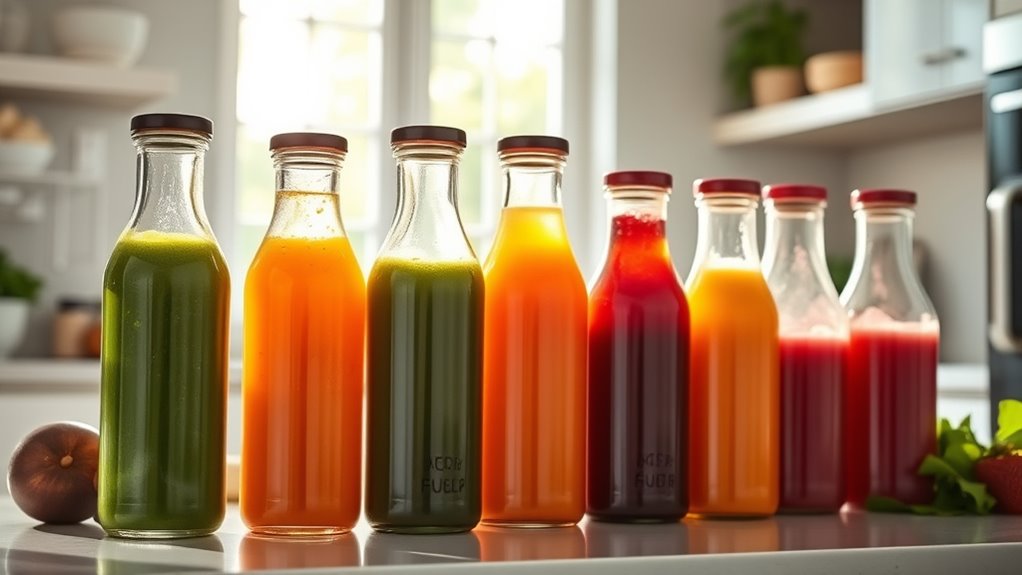
While fresh juice is best enjoyed right after you make it, you can still store it for later use if you follow a few simple guidelines.
To guarantee ideal nutrient retention and extend shelf life, keep these tips in mind:
- Use airtight glass jars: Fill them to the top and seal tightly to minimize oxidation.
- Add a splash of lemon juice: This helps maintain color and adds acidity, which preserves freshness.
- Store away from light and heat: These elements can degrade the nutritional value of your juice.
Easy Juice Recipes

Creating delicious and nutritious juices can be as simple as combining a few key ingredients. Start your juice cleanse by using high-water content fruits and veggies like cucumber and celery for hydration. For a nutrient boost, add leafy greens such as spinach or kale. Naturally sweet veggies like carrots or beets enhance flavor without added sugars. Don’t forget to experiment with fruits like green apples or pineapples for a touch of sweetness. Here are some easy juice recipes to get you started:
| Juice Recipe | Key Ingredients |
|---|---|
| Carrot-Ginger | Carrots, ginger |
| Beet-Celery-Cucumber | Beets, celery, cucumber |
| Apple-Spinach-Lemon | Apples, spinach, lemon |
| Cucumber-Mint | Cucumber, mint |
| Pineapple-Kale | Pineapple, kale |
Drink fresh and enjoy the benefits! Additionally, incorporating high-water content fruits can help keep you hydrated during your juicing journey.
Frequently Asked Questions
What Is the 80/20 Rule for Juicing?
The 80/20 rule for juicing means you should create your juice with 80% vegetables and only 20% fruits.
This balance helps lower sugar content while maximizing nutrient density. By focusing on veggies, you’ll benefit from essential vitamins and minerals, and the high fiber content will slow down sugar absorption, keeping your blood sugar levels stable.
Plus, it encourages variety in your diet, enhancing flavor and supporting your health goals effectively.
Which Vegetables Should Not Be Juiced?
“You can’t have your cake and eat it too.” When it comes to juicing, some veggies just aren’t worth the trouble.
Avoid raw potatoes and eggplant due to their toxic compounds, which can upset your stomach.
Kale and spinach are great, but keep them in moderation because of oxalates.
Broccoli and cabbage might cause gas, so start slow.
Finally, juice beets sparingly to prevent blood sugar spikes.
Enjoy your juicing adventure wisely!
What Are 5 Cons of Juicing?
Juicing has its drawbacks.
First, you’re missing out on essential fiber, which can lead to digestive issues.
Second, juices often lack protein and healthy fats, resulting in nutritional imbalances.
If you replace too many meals with juice, you might feel light-headed and fatigued due to low calories.
Additionally, the natural sugars can spike your blood sugar, posing risks if you have diabetes.
Finally, fresh produce can get pretty expensive, making juicing costly.
What Is the Trick to Juicing?
The trick to juicing isn’t just about throwing fruits and veggies in a blender; it’s about choosing the right ingredients.
You’ll want to use fresh, high-water content produce like cucumbers or spinach for a nutrient boost. A masticating juicer helps retain those nutrients better than a centrifugal one.
And don’t forget to prep your ingredients—washing and chopping makes the process smoother.
Store your juice in airtight containers to keep it fresh longer!
Conclusion
Incorporating juicing into your routine can be a game-changer for your health. Did you know that drinking just one serving of juice can provide you with up to 90% of your daily recommended intake of fruits and vegetables? With the right juicer and some tasty recipes, you’ll be well on your way to enjoying all the benefits juicing has to offer. So grab your juicer, experiment with flavors, and start reaping the rewards today!
Cindy thoroughly researches juicing trends, techniques, and recipes to provide readers with practical advice and inspiration. Her writing style is accessible, engaging, and designed to make complex concepts easy to understand. Cindy’s dedication to promoting the advantages of juicing shines through her work, empowering readers to make positive changes in their lives through the simple act of juicing.

